Floating Solar Photovoltaics Could Make a Big Splash in the USA
July 29, 2019 by Laura Beshilas
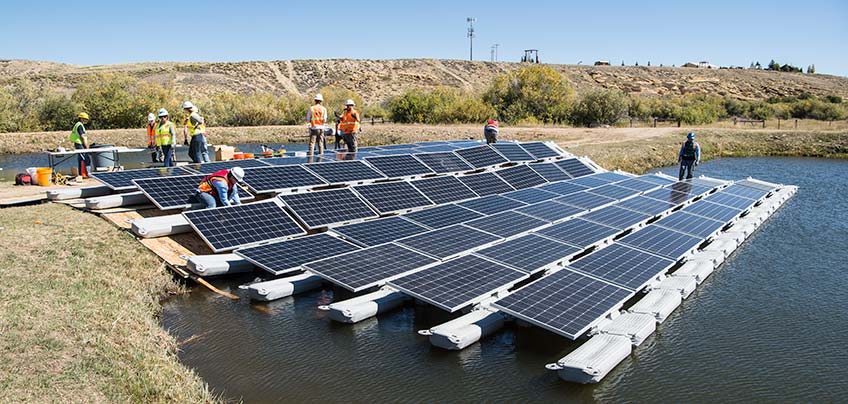
Floating Solar Photovoltaics
A floating solar photovoltaic (FPV) system is an emerging technology in which a solar photovoltaic (PV) system is placed directly on top of a body of water, as opposed to on land or on building rooftops. An NREL blog post from Jan. 24, 2017 discussed FPV and was based on forward-thinking state energy offices inquiring about the technology through NREL’s state technical assistance programs. The blog post introduced the technology and discussed the benefits of FPVs, as well as different examples of pilot FPVs in the United States.
FPV systems are gaining traction across the world (e.g., in the United Kingdom and the Seychelles). A recent market research report by Technavio predicts that the FPV market will grow at a compound annual growth rate of over 31% from 2018-2022. 52% of the growth will come from the Americas. According to GTM Research, annual FPV installations will grow to over 1.5GW in 2019. Figure 2 shows FPV installation history and predictions for geographic locations. Despite the maturation of the FPV market, a comprehensive study of the technical potential of FPV has not been conducted in the continental United States.
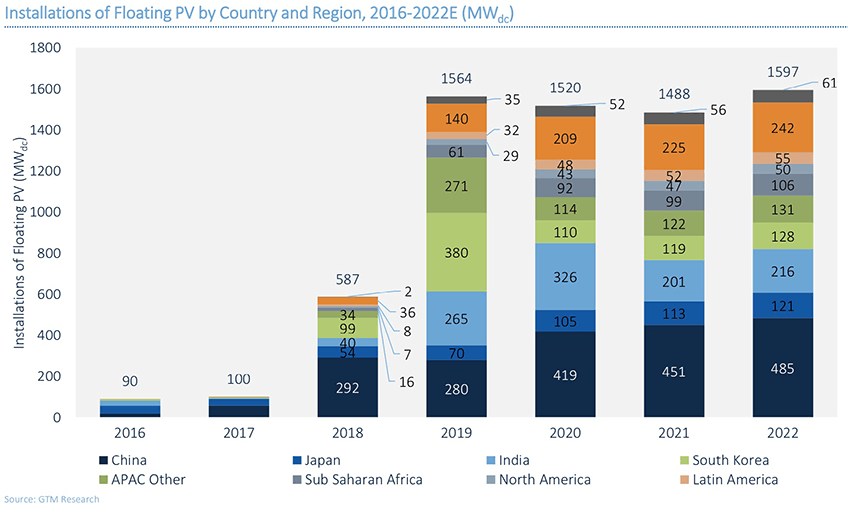
Technical potential is the achievable energy capacity and generation of a technology. It is dependent on system performance, topographic limitations, and environmental and land use constraints. Figure 3 illustrates the factors used to determine technical potential.
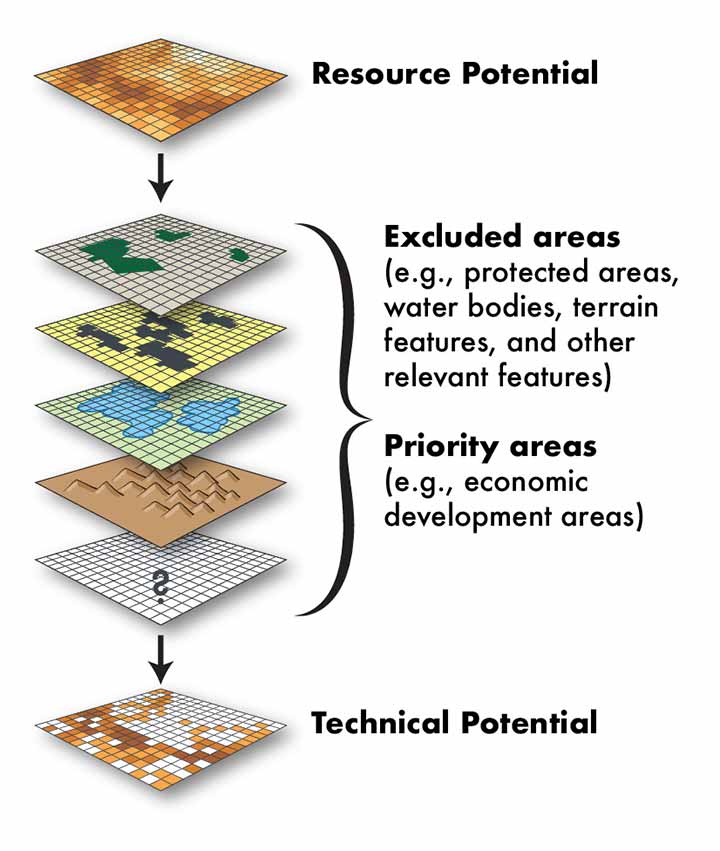
A recent NREL publication, Floating Photovoltaic Systems: Assessing the Technical Potential of Photovoltaic Systems on Man-Made Water Bodies in the United States, quantifies the technical potential of FPV on man-made bodies of water in the United States. It also quantifies the co-benefits of placing PV on water bodies.
Technical Potential of Floating Photovoltaics in the United States
The NREL study of FPV technical potential in the United State found that 24,419 human-made water bodies in the United States are suitable for FPV development. The search was limited to human-made bodies of water because human-made reservoirs are more likely to be managed and therefore have infrastructure and roads in place. This can ease the FPV installation process. In addition, FPV installation on managed bodies of water may have fewer environmental concerns than installations on natural water bodies. The team also chose to focus on human-made water bodies because the currently existing FPV projects are almost all installed on human-made bodies of water.
The suitable water bodies were found by filtering data from the National Inventory of Dams (maintained by the U.S. Army Corps of Engineers) and the National Hydrography Dataset (maintained by the U.S. Geological Survey). The NREL team created size requirements (2 meters deep and a 1-acre surface area). The water bodies were also filtered by primary purpose. Water bodies used for certain purposes were considered infeasible for FPV, such as those used for recreation, tailings, navigation, or fish and wildlife ponds.
The study determined that if 27% of the surface area of these 24,419 water bodies were to be covered in FPV systems, they would generate approximately 10% of the nation’s energy needs.
Co-Benefits of Floating Photovoltaics
In addition to providing solar energy, FPV systems have other benefits. To learn about the benefits of FPV for each state, see Table S1 of the publication’s Supporting Information.
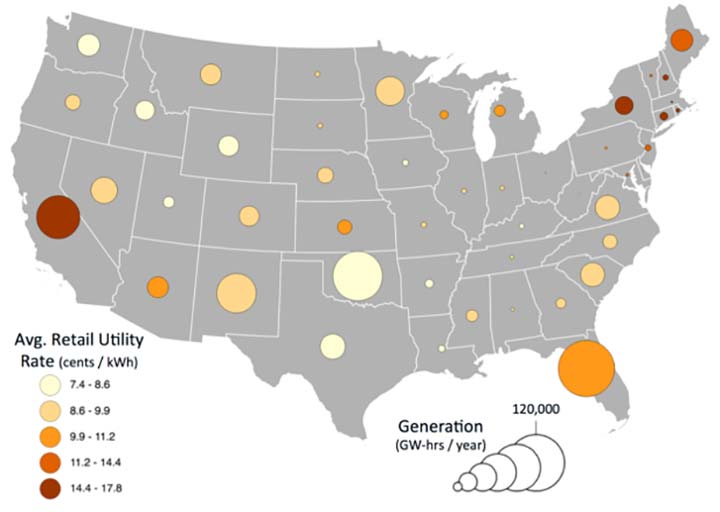
Land Conservation
Siting PV systems on water eliminates competition for land that could be used for other purposes. In the United States, approximately 2,141,000 hectares of potential land savings are available if PV systems are placed on water instead of on land. Figure 4 depicts the cumulative surface area of feasible water bodies for FPV systems and the average state land values. Florida and California have relatively large amounts of water surface area available for FPV, and the cost of land is high. FPV may help land-constrained areas better deal with competing land use pressures.
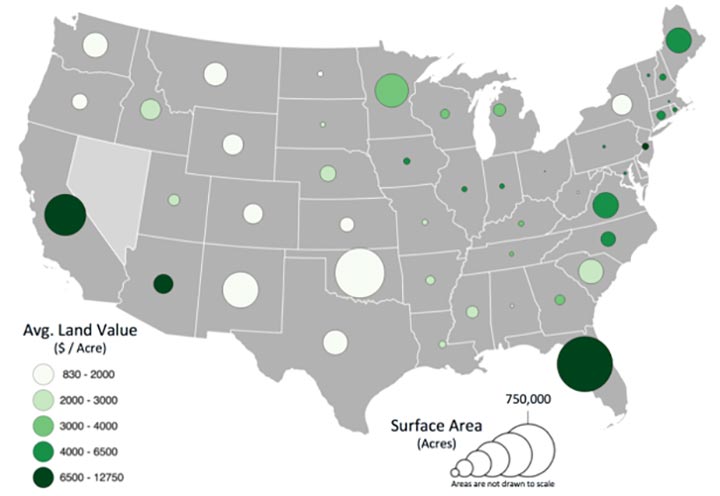
Utility Costs
Like land-based PV systems, FPVs can generate electricity in areas with high local utility costs. Figure 5 shows the average retail utility rate in each state and the potential FPV generation. California could be a good FPV candidate because the state has a high average retail utility rate of 15.5 cents per kWh (compared to the national average of 10.04 cents per kWh) and has a high generation potential of 75.7 TW-hr per year.
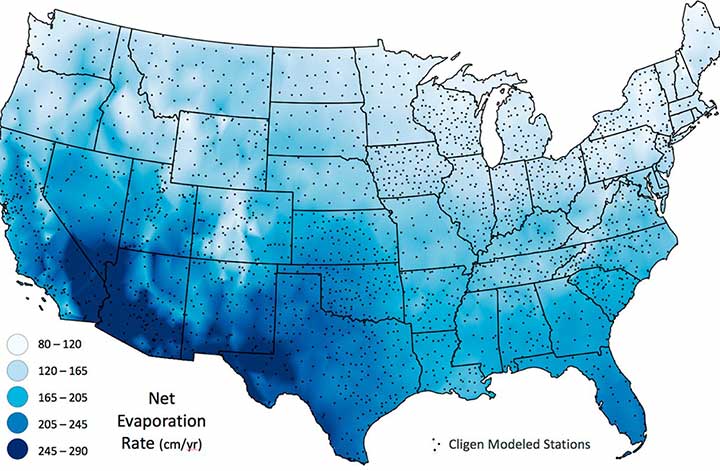
Evaporation Losses
FPV systems can potentially mitigate evaporation losses on human-made water bodies by shading the water. The amount of mitigated evaporation depends on the technology, water body coverage, and individual water body characteristics. Figure 6 shows net evaporation rates in the United States. Each dot on the map represents a potential FPV site according to the study.
The Future of Floating Photovoltaics
Recently, the number of FPV installations has grown rapidly. China, Japan, and South Korea have experienced significant FPV development, and FPV growth is predicted to continue. The United States is also expected to continue installing FPV projects. FPV technology has the potential to help countries reach their solar energy generation goals while also combating land-use issues and providing environmental benefits, such as reduced algal growth and reduced water evaporation. This study can help communities in the United States understand the technical potential and benefits of FPV when planning energy generation projects.
Share
